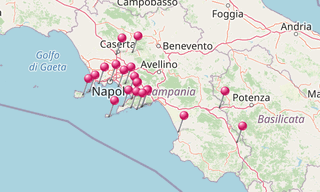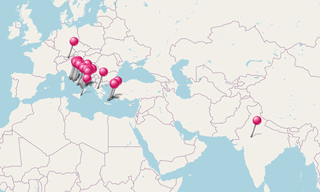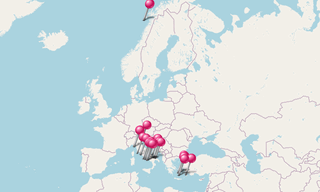The Amalfi Coast (Costiera Amalfitana), on the south of Naples, extends from Positano in the west to Vietri sul Mare in the east.
The towns lying on the Amalfi Coast are:
- Positano: The small fishing village (Population 3,900) lies in an enclave with vertiginous slopes to the sea.
- Praiano: During the 10th - 11th centuries, Praiano was once the summer residence of the doges of the Duchy of Amalfi.
- Furore: Furore expands from sea level, where there is the hamlet of Fiordo di Furore up to Agerola (550 m above sea level)
- Conca dei Marini: In the early Middle Ages, it was a trading base of the Republic of Amalfi. In 1543 it was sacked by Turkish pirates.
- Amalfi: The town is the largest on the coast (Population 5,500). The Duomo still houses some relics of the apostle Saint Andrew’s brought from Constantinople in 1210.
- Scala: In the Middle Ages Scala was, together with Ravello, the most important fortification of the Duchy of Amalfi.
- Ravello: The Villa Cimbrone and Villa Rufolo provide the best views on this coast. In the latter Richard Wagner was inspired in 1880 for his opera Parsifal.
- Minori: An ancient holiday resort of the Roman aristocracy, as evidenced by the discovery of a patrician villa dating back to the 1st century.
- Maiori: Likely founded by the Etruscans, it was conquered by the Romans in the 3rd century BC.
- Cetara: The village was originally a settlement for a group of armed Muslims in 880.
- Vietri sul Mare: The town is known for its polychrome ceramics, a tradition since at least the 15th century, and is considered to be the gateway to the Amalfi Coast.

.hero.landscape.jpg?w=1600)


.jpg?w=256)
.jpg?w=256)
.jpg?w=256)
-Duomo-Sant%E2%80%99Andrea.jpg?w=256)
.jpg?w=256)
-Villa-Cimbrone.jpg?w=256)
.jpg?w=256)
.jpg?w=256)
-Villa-Cimbrone.jpg?w=256)
.jpg?w=256)
-Villa-Rufolo.jpg?w=256)
.jpg?w=256)
-Duomo-Sant%E2%80%99Andrea.jpg?w=256)
.jpg?w=256)
.jpg?w=256)
.jpg?w=256)
-Villa-Cimbrone.jpg?w=256)
-Villa-Cimbrone.jpg?w=256)
-Villa-Cimbrone.jpg?w=256)
-Duomo-Sant%E2%80%99Andrea.jpg?w=256)
-Villa-Cimbrone.jpg?w=256)
.jpg?w=256)
.jpg?w=256)
.jpg?w=256)
.jpg?w=256)
-Villa-Cimbrone.jpg?w=256)
.jpg?w=256)
.jpg?w=256)
-Duomo-Sant%E2%80%99Andrea.jpg?w=256)
.jpg?w=256)
.jpg?w=256)
.jpg?w=256)
.jpg?w=256)
.jpg?w=256)
-Villa-Cimbrone.jpg?w=256)
.jpg?w=256)
.jpg?w=256)
-Duomo-Sant%E2%80%99Andrea.jpg?w=256)
-Villa-Rufolo.jpg?w=256)
.jpg?w=256)
.jpg?w=256)
-Villa-Rufolo.jpg?w=256)
.jpg?w=256)
.jpg?w=256)
-Villa-Cimbrone.jpg?w=256)
.jpg?w=256)
-Duomo-di-San-Giovanni-Battista.jpg?w=256)
.jpg?w=256)
.jpg?w=256)
.jpg?w=256)
-Villa-Cimbrone.jpg?w=256)
-Villa-Rufolo.jpg?w=256)
-Villa-Rufolo.jpg?w=256)
-Villa-Cimbrone.jpg?w=256)
-Villa-Rufolo.jpg?w=256)
.jpg?w=256)
.jpg?w=256)
.jpg?w=256)
-Villa-Cimbrone.jpg?w=256)
.jpg?w=256)
.hero.jpg?w=320)

.hero.jpg?w=320)

.hero.jpg?w=320)

.hero.jpg?w=320)
.map.png)